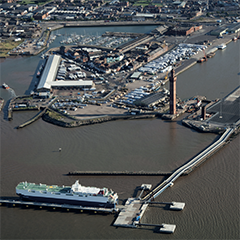How can we make the most of the UK’s green industrial revolution?
As the UK accelerates its journey towards net zero, the offshore wind industry has emerged as a key driver of the green industrial revolution. Associated British Ports (ABP) is investing to meet the industry’s requirements by providing state-of-the-art port infrastructure and creating favourable conditions for energy clusters, which will benefit the wider economy.
Why is the offshore wind industry vital?
The offshore wind industry is particularly important to the UK because of the country’s commitment to a legally-binding 2050 net zero target. Whatever mix of renewables is deployed to achieve this, we will still need a lot of offshore wind energy to support it, with required levels expected to be between 65 and 125 GW. To put this into context, the amount of installed capacity is currently around 10 GW, so there is a long way to go in order to achieve our goals.
There is clearly an opportunity for offshore wind companies to play a leading role in the UK’s green industrial revolution. The Government has also strengthened the market by announcing its ambitions for a green recovery, in a series of public policy documents. As a result, there is a whole host of different projects ready to bring additional offshore wind capacity to the market and The Crown Estate continues to lease new seabed rights.
As the UK’s leading and best-connected port operator, ABP is an ideal partner for offshore wind energy businesses. We have over 30 years’ experience in supporting developers through the full offshore wind project lifecycle. One of the biggest offshore wind projects the company has supported over the years is Green Port Hull, where leading wind turbine supplier Siemens Gamesa Renewable Energy has been manufacturing offshore wind turbine blades since 2016 and has facilitated the load out of over 2GW of turbines from the 54-hectare, £310 million state-of-the-art production and assembly facility. Building on this experience, the company is exploring other opportunities across its estate of 21 ports to attract more manufacturers into the UK.
How can we make the most of the UK’s green industrial revolution?
As the UK accelerates its journey towards net zero, the offshore wind industry has emerged as a key driver of the green industrial revolution. Associated British Ports (ABP) is investing to meet the industry’s requirements by providing state-of-the-art port infrastructure and creating favourable conditions for energy clusters, which will benefit the wider economy.
Why is the offshore wind industry vital?
The offshore wind industry is particularly important to the UK because of the country’s commitment to a legally-binding 2050 net zero target. Whatever mix of renewables is deployed to achieve this, we will still need a lot of offshore wind energy to support it, with required levels expected to be between 65 and 125 GW. To put this into context, the amount of installed capacity is currently around 10 GW, so there is a long way to go in order to achieve our goals.
There is clearly an opportunity for offshore wind companies to play a leading role in the UK’s green industrial revolution. The Government has also strengthened the market by announcing its ambitions for a green recovery, in a series of public policy documents. As a result, there is a whole host of different projects ready to bring additional offshore wind capacity to the market and The Crown Estate continues to lease new seabed rights.
As the UK’s leading and best-connected port operator, ABP is an ideal partner for offshore wind energy businesses. We have over 30 years’ experience in supporting developers through the full offshore wind project lifecycle. One of the biggest offshore wind projects the company has supported over the years is Green Port Hull, where leading wind turbine supplier Siemens Gamesa Renewable Energy has been manufacturing offshore wind turbine blades since 2016 and has facilitated the load out of over 2GW of turbines from the 54-hectare, £310 million state-of-the-art production and assembly facility. Building on this experience, the company is exploring other opportunities across its estate of 21 ports to attract more manufacturers into the UK.
To read the full content,
please download the PDF below.



























